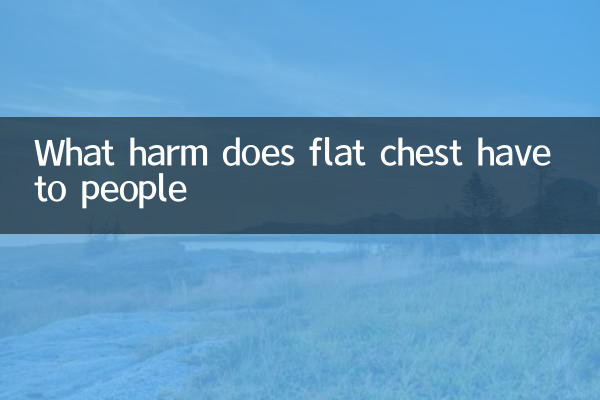What harm does flat chest have to people
Flat chest is a disease with abnormal thoracic development, mainly manifested in a significantly reduced anterior and posterior diameter of the chest, flattened or even sunken. This disease not only affects appearance, but may also have many effects on physical health. The following is a detailed analysis of the hazards of flat chests.
1. Definition and classification of flat chest

Pectus Excavatum is a congenital thoracic deformity that is mainly manifested in depressions in the sternum and ribs. According to the severity, it can be divided into mild, moderate and severe. The following are the classification criteria for flat chests:
| Classification | Depth of depression (cm) | Appearance performance |
|---|---|---|
| Mild | 1-2 | Slightly sunken chest, no obvious discomfort |
| Moderate | 2-4 | Significant depression in the chest may be accompanied by mild dyspnea |
| Heavy | >4 | Severe depression in the chest may affect cardiopulmonary function |
2. The harm of flat chest to the human body
The harm of flat chest is mainly reflected in the following aspects:
1. Impact on the respiratory system
Flat chest will cause the volume of the chest cavity to shrink, compress the lungs, and affect the normal expansion of the lungs. In the long run, it may lead to a decrease in lung capacity, causing chronic dyspnea, and in severe cases, it may even cause lung infection.
2. Impact on the cardiovascular system
Severe flat chest may compress the heart and affect the normal blood pumping function of the heart. Here are the potential effects of flat chest on the cardiovascular system:
| Influence | symptom | Possible consequences |
|---|---|---|
| Heart pressure | Palpitations, chest tightness | Arrhythmia |
| Limited blood flow | Dizziness, fatigue | Heart failure |
3. Impact on mental health
Patients with flat chests often develop inferiority complex due to abnormal appearance, especially in adolescence, which may cause psychological problems such as social fear and depression.
4. Impact on athletic ability
Due to limited cardiopulmonary function, patients with flat chests usually have poor endurance in exercise and are prone to fatigue, which affects daily activities and physical exercise.
3. Treatment and prevention of flat chest
The treatment methods for flat chest include surgical and non-surgical. Surgical correction is suitable for moderate to severe patients, while non-surgical methods such as physical therapy, respiratory training, etc. are suitable for mild patients. Here are common treatments:
| Treatment method | Applicable groups | Effect |
|---|---|---|
| Surgical correction | Moderate and severe patients | Significantly improve thoracic morphology and cardiopulmonary function |
| Physical Therapy | Mild patients | Relieve symptoms and improve respiratory function |
| Breathing training | All patients | Enhance lung capacity and improve breathing |
4. How to prevent flat breasts
Flat chests are mostly congenital, but acquired bad postures may also aggravate the symptoms. Here are some tips for preventing flat chest aggravation:
1. Maintain correct sitting and standing posture and avoid hunchback.
2. Regular chest stretching and breathing training.
3. Strengthen physical exercise, especially swimming, yoga, etc., which helps to expand the chest.
5. Summary
Flat chests not only affect appearance, but may also cause harm to the respiratory system, cardiovascular system, mental health and exercise capacity. Early detection and appropriate treatment and preventive measures can effectively improve symptoms and improve quality of life. If you or the people around you have flat chest problems, it is recommended to seek medical treatment in time and seek help from a professional doctor.

check the details

check the details